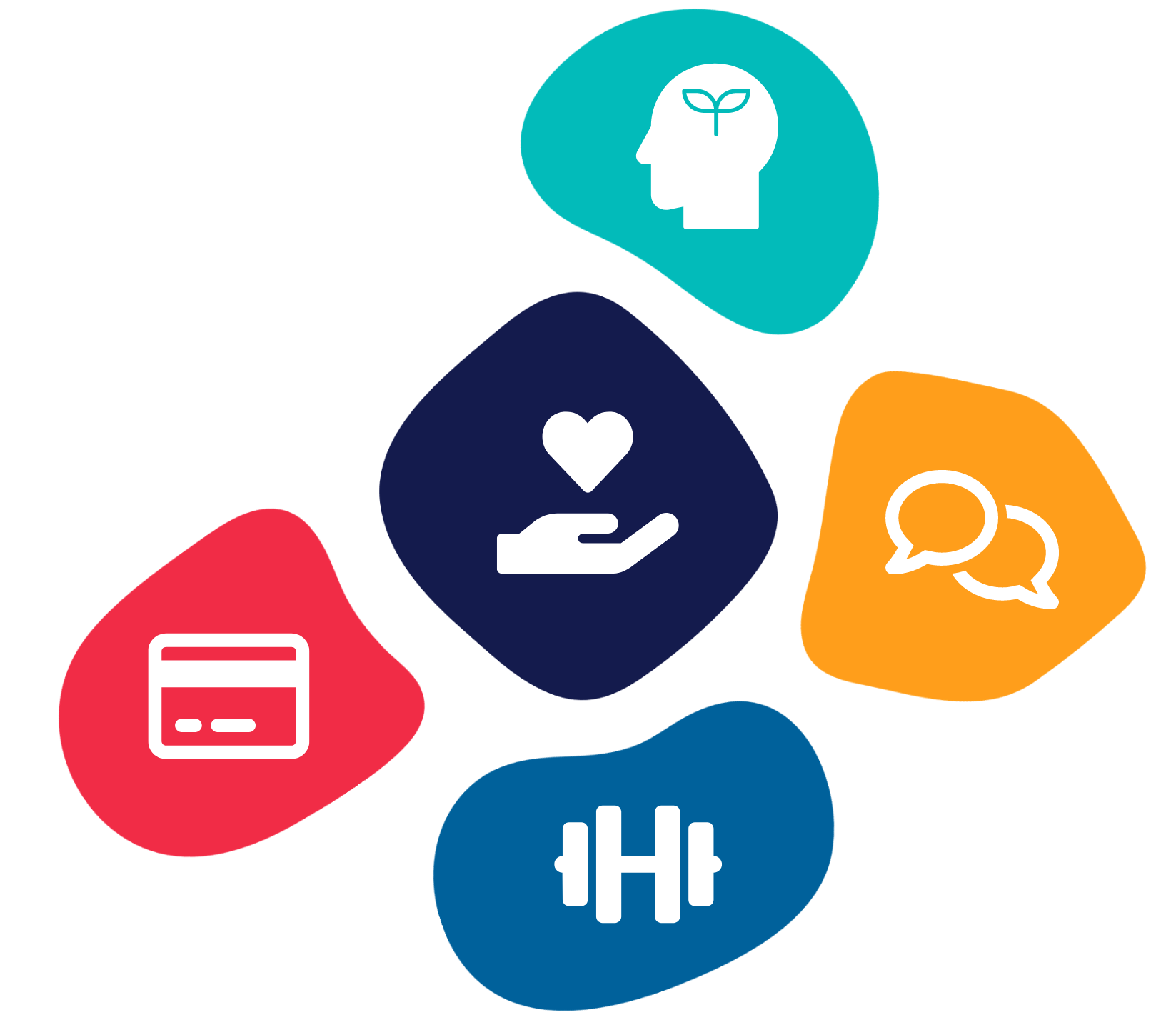Words like “wellbeing” “wellness” and “corporate wellbeing program” are buzzwords that are more and more popping up on businesses’ radar, and for a good reason. Never has employee wellbeing been more important than now, after slowly recovering from a global pandemic where employees from one day to the next found themselves taking all their belongings home to work from home indefinitely, others being furloughed, and still others being overworked due to limited resources.
Happy employees not only mean productive employees but also allows you to keep your people, i.e., less turnover. Ideally retention rates would hover around 90% or higher, with the highest retention rates being in the government, finance, insurance, and education sectors. This is why paying attention and improving employee wellbeing is fundamental.
In this guide we will look at what is wellbeing, digital wellbeing and how to develop a successful program with measurable results. Whether you’re a small, medium-sized, large or remote company, creating a corporate wellbeing program is a must.
What is wellbeing?
What is wellbeing and what does wellbeing mean? These are some questions that those getting a fresh start in HR or designing a corporate wellbeing program will need to know. According to the Oxford Dictionary, wellbeing (also written well-being) is defined as: “ the state of being comfortable, healthy, or happy.”
The 4 pillars of wellbeing
Wellbeing is commonly broken down into 4 pillars:
- Mental Wellbeing
- Social Wellbeing
- Physical Wellbeing
- Financial Wellbeing

There are some schools of thought that break the wellbeing pillars into 5 core ideas, including community, while still others break it into 8 pillars, including: environmental, spiritual, nutritional and intellectual wellbeing. For the sake of a corporate wellbeing program, we will focus on the four main pillars demonstrated in the graphic above as they relate to the work sphere. It should be noted that all these pillars work together to create a holistic state of wellbeing.
Mental wellbeing
The key to mental wellbeing is being emotionally and psychologically healthy, so that your employees feel a sense of purpose in their jobs and can enjoy their lives outside of work. Mental wellbeing has a lot to do with work-life balance.
Mental health in the job setting has a lot to do with fulfilling your life’s purpose and feeling that you are being rewarded according to the work you put in. Mental health at work is being able to interact positively with coworkers to foster healthy relationships. With more and more work being done remotely, it’s extra important to help create this sense of mental wellbeing when the human component is not physically present.
Find out how to improve mental health when traveling for business.


Social wellbeing
Social wellbeing is all about maintaining positive social interactions and creating healthy relationships. Encourage your workers to treat fellow coworkers with the respect and the support they need so that there is a ripple effect in the office. An environment of mutual respect and teamwork does wonders for your team’s social wellbeing.
Physical wellbeing
Physical wellbeing is about encouraging your employees to live an active and healthy lifestyle while at the same time also providing them with ergonomic office spaces that allow them to work comfortably and in a way that is not damaging to their physical body. When people are in pain or have poor physical health, this can lead to mental health and other issues, and make them less happy overall.


Financial wellbeing
While money isn’t everything, unfortunately, we can’t live without it. Financial wellness is about providing employees with decent salaries so that they can adequately cover everyday expenses and incidentals, as well as be able to give themselves some “luxuries.” Feeling free and in control of financial decisions, while being able to save, budget and manage spending is key to financial wellbeing.
What is a wellbeing program?
A wellbeing program in the business world is a series of actions a company takes to support and encourage employee wellness and create a healthy organizational culture. Normally it is a playbook or action plan made up of different activities designed to promote health and wellness within the workplace. The ultimate goal of a program is to foster healthy habits among your employees, which ultimately increases productivity and boosts engagement.
Why wellbeing in a corporate environment is important
According to a report by BCD Travel, traveler happiness and wellbeing is the second most important travel program priority after duty of care. The travel management company surveyed 118 travel buyers worldwide, with 92% of survey respondents ranking the topic as extremely or very important.
Wellbeing in the workplace is extremely important in order to have a balanced environment where employees feel valued, recognized, and have opportunities for growth and development. According to the American Psychological Association, lack of opportunity for growth or advancement is the second source of job stress, after low salaries.
A healthy workplace is key to creating an environment where employees can flourish by being fulfilled mentally, physically, socially and financially. Offering services like counseling, employee assistance programs and occupational health services, while at the same time supporting managers so that they can guide their teams to their best potential while encouraging good self-care and getting enough sleep is key to fostering a positive work environment.
10 Foundations of a corporate wellbeing program
Now that we’ve gotten a better understanding of what is wellbeing, let’s look at some of the foundations of a corporate wellbeing program, integrating the learnings into a dynamic program that will encourage employees to be the best they can be.
1. Think about digital wellbeing
You may wonder what is digital wellbeing? These two words seem to be counterintuitive, but it is essentially using technology to ensure an employee’s health or wellbeing. It means encouraging a healthy use of technology such as social media, but also encouraging employees to take time to disconnect from their devices.
You may consider implementing digital wellbeing apps, which allow you to keep track of your screen time, alerting employees when it’s time to take a break. Or other programs like slack allow you to set aside focus time so that you turn off notifications during a certain time so as not to be disturbed. You can even install a mindfulness bell that reminds you to take a break and meditate or stretch. Having off-screen time during the day is key for reducing stress.
2. Reduce meeting times and frequency
For companies, especially those working remotely, it’s important to try to reduce “zoom fatigue” by having shortened meeting times, for example maximum 15-20 minutes. On the other hand, in-person meetings should also be kept under an hour and with a clear goal in mind. Make sure if meetings go longer to have a break worked in. Having a “less is more” meeting policy is ideal for productivity.
Related article
3. Encourage a healthy lifestyle
Businesses can encourage a healthy lifestyle by including health benefits in your company’s benefits package, supplying a healthy lunchtime meal for free or at a reduced cost, and having healthy snacks like fruit or smoothies readily available. You can also provide a gym membership for free or subsidize it to encourage employees to live a healthy lifestyle. Having free psychological counseling in the office or with a provider is also a great added resource. Learn tips for keeping a healthy lifestyle as a business traveler.
4. Create a program for growth
Having an internal growth program to create a career path is key not only for mental wellbeing but also for financial wellbeing. Knowing that there is a clear plan of action in mind to grow within the company is great for keeping your employees and also giving them a goal to work towards. Having different milestones set up accompanied by a salary increase will do wonders for your employees’ financial wellbeing.
5. Have “giving back” policy
Giving back to the community or to charities does wonders for social and mental wellbeing. And the happier your employees are, the better work they will do. When creating a corporate wellbeing program consider what benefits you will give to your employees for “giving back.” Whether it’s giving employees a free day to engage in community service or matching charitable donations, it’s important to create an environment where doing things for a good cause are rewarded. This is an important part of creating meaninful business travel experiences.
6. Make sure your company’s values are known and recognized
Creating and making publicly available your company’s values is important for workers to feel proud of where they work. Define a series of values like sustainability, community, learning, and support these values with a clear action plan.
For the “sustainability,” value, favor partnerships and providers who work sustainably; for community, be sure to give back to the community and create a symbiotic relationship with surrounding businesses; for learning, give employees the chance to participate in courses or give them a budget for extended learning programs. Employees will feel more connected to their work and company they work for if they identify with their company’s values.

7. Provide benefits that support financial wellbeing
Create a series of benefits for employees in addition to their salary that give them an opportunity to feel financially stable. That could be providing better salaries, bonuses, early retirement, and a plethora of other financial benefits that make sense depending on the country where your company is based. In the US for example, a 401k, stock options, a lifestyle savings account and flexible spending are all examples that give employees that added financial security.
8. Personal days and vacation days
Create a company policy where personal days to take care of public duties, moving, going to the doctor, a bank appointment, are all easily accessible. On top of this, make sure to have a generous vacation policy. Some companies have started giving unlimited vacation days, whereas other companies give some additional days on top of the state-mandated vacation days. Taking time off is essential for mental wellbeing.
9. Teambuildings and office get-togethers
Giving your staff the opportunity to work together and to work together well, is the foundation of establishing a team bond. In order to do this, design teambuildings like group hiking trips, creating a book club, sports clubs, a cooking class, going out to dinner, and after-work beers. All of these activities are great for social wellbeing and giving people a sense of belonging and being invested in their coworkers and thus, the company.
10. Adapt your corporate wellbeing program to the current circumstances
Of course, times are constantly changing. For this reason, make sure that your program is flexible and encompasses new and dynamic practices designed to adapt to changing circumstances.
To facilitate a smooth and hassle-free business trip while keeping living up to your duty of care, work with a digital TMC like GetGoing that is flexible and keeps your traveler’s safety at the forefront.
Happy workers and travelers are more productive, more invested in their jobs and have a balance between their emotional, physical, financial and mental wellbeing that helps them to be the best employees they can be. So the question isn’t why is a corporate wellbeing program important, it’s what are you doing now to start your program?


